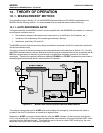
THEORY OF OPERATION M300EU
Addendum to M300E/EM Manual P/N 04288
The dryer consists of a bundle of 0.030" O.D. Nafion
®
tubes housed within a single large tube shell. Sample gas
flows within the Nafion tubes while water vapor absorbs into the tubular membrane walls and is removed.
Moisture permeating the tubing is carried away by a dry purge gas within the shell that flows countercurrent to
the sample gas.
This process is called per-evaporation and is driven by the humidity gradient between the inner and outer tubes
as well as the flow rates and pressure difference between inner and outer tubing. Unlike micro-porous
membrane permeation, which transfers water through a relatively slow diffusion process, per-evaporation is a
simple kinetic reaction. Therefore, the drying process occurs quickly, typically within milliseconds.
The first step in this process is a chemical reaction between the molecules of the Nafion
®
material and water,
other chemical components of the gases to be dried are usually unaffected. The chemical reaction is based on
hydrogen bonds between the water molecule and the Nafion material. Other small polar gases that are capable
of hydrogen bonds can be absorbed this way, too, such as ammonia (NH
3
) and some low molecular amines.
The gas of interest to the M300EU, CO, does not get absorbed and passes though the dryer unaltered.
To provide a dry purge gas for the outer side of the Nafion tube, the M300EU returns some of the dried air from
the inner tube to the outer tube (see Figure 3-2).
When the analyzer is first started, or if the instrument is turned on after having been off for more than 30
minutes, the humidity gradient between the inner and outer tubes is not very large and the dryer’s efficiency is
low at first but improves as this cycle reduces the moisture in the sample gas and settles at a minimum humidity.
The dryer used in the M300EU is capable of adequately drying ambient air to a dew point of ≤ -6˚C (~4000 ppm
residual H
2
O) at the flow rate of the analyzer.
52 05831 Rev. 01


















